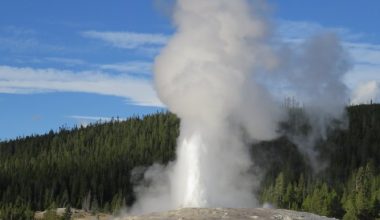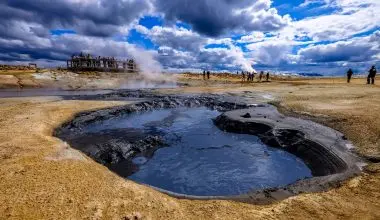Table of Contents Show
What is Geothermal Energy?
Geothermal Energy is thermal energy generated from the Earth’s core which gets stored into Earth’s layers and warms them up. Thermal energy is basically the heat stored in matter, which in this case is the Earth.
Geothermal energy works best to eliminate natural gas or oil as it is a great alternative to reduce energy bills and get tax reliefs. It uses the earth’s controlled temperature (between 32 to 75 degrees Fahrenheit) to keep your home cool in summers and warm in winters.
At first it wouldn’t make sense to install a geothermal heating plant, especially with high initial costs, but it does result in enormous economic savings in the long run.
Let’s discuss the Advantages and Disadvantages of geothermal energy. The table summarizes them and then we’ve discussed them in-detail ahead.
| Pros of geothermal energy | Cons of geothermal energy |
| It is very environment-friendly when compared with other energy sources; producing zero greenhouse gas emissions* | The installation of a geothermal plant requires an investment of up to $7 Million. |
| Geothermal energy is highly efficient, around 400%. More efficient than 90% of energy sources. | Requires a large open-space to install and would require large scale digging. |
| Geothermal energy is a renewable resource. This means it is eternal, lasting as long as the earth exists. | The heating pumps of geothermal energy require electricity to operate. Although it’s negligible. |
| Geothermal energy is accessible to all. From small houses to the largest commercial spaces, anyone can make use of it. | The geothermal plant requires lots of water which might be difficult to obtain in drought-affected areas. |
| Since geothermal plants are not powered by gas or oil, there are no cost fluctuations with changes in oil prices. | Large geothermal plants can be dangerous to earth’s surface. |
| Geothermal energy helps to reduce bills; saving roughly up to 60% on heating and 50% on cooling. | Underground looping of heat-source pumps is very difficult to get fixed if it gets damaged. |
| Geothermal energy uses heat energy already produced in Earth’s core; this improves efficiency and makes it readily available. | |
| Most of the geothermal plant is underground with small changes above the ground in landscape design. | |
| Geothermal plants can work round the year as it is not seasonal. | |
| The heating pump on the geothermal plant is not dangerous; especially when turning off like furnaces when they run out of oil or gas. | |
| Geothermal energy is eligible to tax cuts. This means that if you install a geothermal plant, the government will give you tax reliefs. | |
| No Noise Pollution. The geothermal plant has no compressor or fan which makes them work quietly. | |
| Geothermal plants have a very long life span, lasting up to 30 years on average. | |
| The plant has fewer moving parts which mean lower maintenance costs. | |
| Geothermal Energy has an extremely high potential. With further development, it can generate 2 TW of power for the whole world. |
*The geothermal heating pump itself produces zero emissions. However, if the minimal electricity used by heat pumps is sourced from non-renewable energy sources; then obviously emissions did get produced over the process.
Now Let’s get into more detail of pros and cons of Geothermal energy.
Advantages of geothermal energy
Renewable
Geothermal energy is said to last as long as the earth lasts. Geothermal energy uses heat reservoirs below the Earth’s surface which makes it sustainable and renewable.
Considering the temperature of the Earth’s core 5000K as of now, and that it has reduced only by 250K since the Solar System formed 450 Billion Years ago; we are looking at a rate of 55 degrees reduction every Billion years.
Reading that data, it would seem that it will take 91 billion years for the Earth to cool down to 0K where no organism can exist!
This is why we can rest assured that Geothermal Energy is Renewable.
Environment-friendly
When compared with other sources of energy, geothermal energy is considered to be more environment-friendly. To better understand this, the carbon footprint from geothermal energy is negligible when compared with fossil fuels.
However, If fossil fuels are used to generate Electricity for running the heat pump in Heat-source pumps; then there can be an indirect environmental footprint as described just below the table.
Sustainable
Geothermal is considered to be more stable and sustainable than solar and wind power because it can be trapped in a way that its supply is constant or the way we want it to be. Whereas we cannot trap wind and solar power; and even if we were to do that, it may not give promising results.
Huge potential
Geothermal energy has a lot of potential. The overall consumption of the world is only around 12 Gigawatts right now. With proper research, development and use of more reserves we can greatly increase production of geothermal energy up to 2 Terawatts of power for the whole world.
Reliable
Geothermal power is reliable and consistent when compared with solar and wind power. We can expect research estimations to be accurate because the data is consistent and reliable.
No fuel required
The geothermal plant requires no fuel to operate and make energy. Whereas, conventional power plants require a lot of fuel in order to produce energy. As we suggested, geothermal is “clean and green”.
Earth provides best temperatures for thermal power plants
It has been observed that the best temperature on which a geothermal power plant can make its turbines work effectively is 150 degrees Celsius. The geysers underground have temperatures enough to run those turbines and make electricity. The temperature difference can be obtained from the ground or added from the Earth’s surface only if needed. The ground can basically act as a great space for geothermal power pumps installed just 2 meters below the surface.
Continuous Research and Development
Continuous research and development is helping us find new places to install geothermal power plants. This is also helps to improve the energy process and gain most out of such power plants. Over the years, geothermal projects are increasing and the industry is growing. If we keep on making progress like this the cons for geothermal energy are going to be eliminated very soon.
Disadvantages of geothermal energy
High Initial Investment
It is considered to be a long term investment, as the geothermal energy is very expensive. Around $2-7 million are required to set up a single geothermal power plant that is able to generate 1 megawatt of energy. So, the upfront costs are high.
Earthquakes
The disadvantages of large-scale geothermal power plants cannot be ignored. Geothermal plants have the potential to cause earthquakes. This is because geothermal plants require digging and the bigger geothermal power plants which require excessive digging have more potential to trigger an earthquake.
In most of the cases, geothermal power plants are set up away from towns and cities. This way if earthquakes do happen, they have a lower impact on population.
Environmental side effects
As we have discussed earlier, geothermal power plants do not release greenhouse gasses during operations. However, while digging many gasses trapped underneath the earth can be released into the atmosphere.
Location restricted
This can be considered as the biggest disadvantage of geothermal power plants. These plants are build where the energy is available in abundant supply i.e. geysers. These locations are then used and restricted for public use. If you live near such a location, you might have to face problems.
So you should be careful before shifting to a neighborhood near thermal power plants.
Sustainability
Geothermal energy needs to be properly managed in order to keep it sustainable. The energy fluids need to be pumped back into the reservoirs quicker than it is depleted.
Chemical Exposure
While drilling for geothermal power plants, workers can get exposed to various harmful chemicals trapped underneath the earth. The release of those chemicals could be very dangerous to health of labor.
Conclusion
Geothermal Energy has tremendous advantages and could prove to be a great resource of renewable electricity generation around the world.
However, we do need to proceed with caution considering these disadvantages. Continuous research and development will hopefully reduce the risks associated with geothermal energy.





2 comments
I find it fascinating that geothermal energy is a renewable source of energy that could heat up or power up several of your home’s appliances. I heard that my colleague wants to build an environmentally friendly home in the countryside. Maybe we should find a geothermal expert that can use this to warm up his home during winter!
Hi Zachary!
Yeah you should definitely look into Geothermal energy to power your needs!
I am glad you enjoyed reading this article.
Regards,